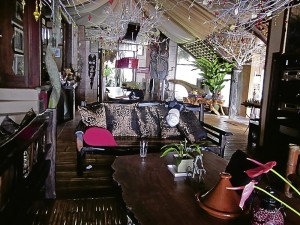
To her numerous friends, Estee Rivera Wallace is the closest thing to being the Martha Stewart of the Philippines. Smart, resourceful and full of creative energy, Estee can cook a gourmet meal and decorate a room with equal aplomb.
In Lake Caliraya, she and her husband Peter have built The Sanctuary, a private resort that not only combines indigenous materials with all the comforts of modern living, but is also unconventional while being traditional. Rather than having one large, single structure, for instance, the Wallaces have a cluster of individual huts fronting the lake that houses a gazebo, a Japanese room, a country kitchen, a game room, as well as bedrooms for the couple and their children.
Though the huts are made of rustic materials such as anahaw and bamboo, the interiors have all the modern furnishings that make for easy relaxation: LCD television screens provide evening entertainment, diaphanous tulle fabric suspended from the ceiling hover protectively over four-poster beds, chaises lounge offer comfortable seating for watching the sunset, and a well-equipped bar stores the Wallaces’ wine collection not far from a freezer filled with ice cream treats. At night, decorative chandeliers tucked amid graceful swags of silky fabric create a luminescent glow.
With Estee doing most of the cooking, a day spent in the Wallaces’ lakeside home always means great food. During a recent weekend she served friends a dinner that started with crisp edamame beans and a salad of salmon and carrot curls, followed by Japanese fried rice cooked on the teppanyaki table, large deep-sea prawns, and juicy tenderloin steak sliced into bite-size pieces.
Breakfast was equally scrumptious, with platters of fresh fruits, longganisa, tapa and rice—all served with steaming cups of brewed coffee and tea. At snack time there were native delicacies such as bibingkang malagkit and tibok tibok with thick latik topping.
What I found intriguing was the tikuron, an inventive dish Estee concocted. It was like turon, except that instead of bananas, the filling encased in the spring roll wrappers was tikoy, the Chinese delicacy made of glutinous rice.
Ever generous, Estee gladly shared the tikuron recipe with me. Readers will find this a fun and delicious way to cook and eat tikoy.
1 whole tikoy (around 1 kilo)
22-25 spring roll wrappers or lumpia wrappers
½ c water
½ c sugar
2 c cooking oil
Slice the tikoy lengthwise into ¼-inch-thick pieces around 5 inches in length. A one-kilo round tikoy will yield around 22-25 pieces.
Brush the edges of a spring roll wrapper with water. Position a sliced tikoy on the wrapper. Sprinkle lightly with some of the sugar then roll to enclose the tikoy completely, pressing the edges to seal. Repeat with remaining tikoy and wrappers.
Heat cooking oil in a wok or frying pan to medium heat. Oil should be sufficiently hot so wrappers don’t stick on the pan, but it should not be too hot (see tips). Fry the wrapped tikoy in the hot oil until golden brown. You may have to do this in batches so as not to crowd the pan. Remove the tikuron from the hot oil and transfer to a plate lined with food-grade absorbent paper or paper towels. If desired, sprinkle with additional sugar while still warm.
For more tips, recipes and stories, visit author’s blog, www.normachikiamco.com, and Facebook fan page, www.facebook.com/normachikiamco. Follow on Twitter@NormaChikiamco.
Cook’s tips:
Tikoy tends to be sticky. When slicing it, brush the knife with cooking oil or spray it with nonstick cooking spray so the tikoy doesn’t stick to the knife.
If using a round tikoy, some of the pieces will be larger than the others (because of the round shape). If they are too large for the spring roll wrappers, just trim the ends. You can wrap the trimmed parts in wonton wrappers, following the same instructions as for wrapping the tikoy in spring roll wrappers. You will then have some wonton tikoy to serve with the tikuron.
The oil should only be moderately hot so that the tikoy filling gets cooked before the wrapper becomes golden brown.
You can use either white sugar, brown sugar or muscovado sugar.